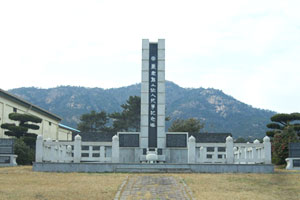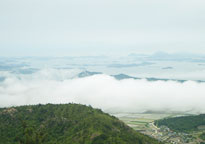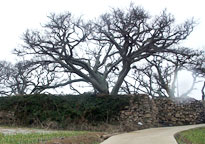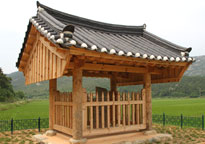
Amtae-myeon where righteous peasants' souls are still breathing
Anjwa-myeon, hometown of Suhwa, Hwan-Ki Kim, western-style painter
Amtaedo is located at the tip of southwest sea, 23.5km away from the west of Mokpo in straight line distance (longitude 126°16' east and latitude 34°39' north) and faces eastward to Yudal mountin of Mokpo, southward to Palgeum-myeon, and northward to Jaeun-myeon. It takes 1 hour 20 minutes by ship from Mokpo harbor.

Mt. Seungbong

Ikgeumwoosil

Maehyangbir
The name of Amtae came from so many scattered stones and rocks surrounding the island like folded screens. About 600 years ago, Choi arrived to the island first to live
When the head of a ship arrives to Amtaedo, Seungbong mountain (sea level 355m) soaring firmly in the center of the island like a strong man's manly spirit welcomes the visitors. Amtaedo has a long history far up to Sanggo-era and 13.25㎢ farmland in the total area of 40.08㎢. Thus, from the old days, there were abundant agricultural products such as rice, barley, garlic, etc. and now algae-cultivation contributes to the income.
The rice of Imtaedo is known for its excellent quality unique from the reclaimed land and along with this land, Amtaedo is a town with the history and weight smeared with ancestors' blood, sweats, tears and wails.
'Amtaedo tenancy dispute' in 1924 was the first tenancy dispute in Korea. During the dispute movement to lower the high-rate farm rent between Aug. 1923 and Aug. 1924, many peasants resisted the high-rate rent by not paying and were arrested.
To commemorate this, in 1998, 6.74m high and 1,360㎡ sized 'Amtaedo peasants' resistance memorial monument' was built and all remembers the noble peasants' resistance in Amtaedo.
By the construction of Eunam bridge connecting Jaeundo, this area became more attractive to tourists as a course of island-tour full of historic experiences, charming scenes, and stories.
Nodu connects Sukok-ri and Chupo-ri and is a rare one that is hard to be found on any other islands. During the ebb, the 2.5km stepping-stone bridge has ..served as a road in the sea to the residents in Chupo-ri. To prevent slipping, residents flip over thousands of stones once a year. Crossing Nodu and going to Chupo-ri, people can find Chupo beach. Now there is cement-covered road next to Nodu (open on June 30, 2000), Nodu can be seen from a car while driving.
Maehyang monument in Songkok-ri located in 'Monument Street', 2 km away east from Janggo-ri, Amtae-myeon, was established in 1405 and is a relic of Mireuk faith that is found in 3~4 coastal areas in Korea. 157cm high, 65cm wide, and 30cm thick Maehyang monument was found in the state that letters were engraved on the flat side of the unrefined natural stone. The 7-line letters read that as a ritual to meet with Mireuk to be reborn someday, Juniper tree was buried in the sea (Maehyang ritual) and it was left as a record. Maehyang monument in Songkok-ri is unique in that it was found in an island throughout Korea.
In addition, Noman temple located in the bottom of Seungbong mountain in Sukok-ri is the oldest temple in Shinan-gun and was built in 1873. It is a small temple and a sub-temple to Daeheung temple in Haenam. Being special .. that it was built in the mountain in the sea area, the temple is composed of 1 Daewungjeon, 1 Chilseonggak and 1 Yosache and has the uterus-shaped mineral-water spring behind the sanctum that does not dry even during 10-year drought and the sea viewed from the temple is just breathtaking. Thus, this area is an essential course in the tour of Amtae.
In addition, there are cultural relics of Ikgeumwooshil of Shinseok-ri and Songkokwooshil of Songkok-ri in Amtaedo.
When the head of a ship arrives to Amtaedo, Seungbong mountain (sea level 355m) soaring firmly in the center of the island like a strong man's manly spirit welcomes the visitors. Amtaedo has a long history far up to Sanggo-era and 13.25㎢ farmland in the total area of 40.08㎢. Thus, from the old days, there were abundant agricultural products such as rice, barley, garlic, etc. and now algae-cultivation contributes to the income.
The rice of Imtaedo is known for its excellent quality unique from the reclaimed land and along with this land, Amtaedo is a town with the history and weight smeared with ancestors' blood, sweats, tears and wails.
'Amtaedo tenancy dispute' in 1924 was the first tenancy dispute in Korea. During the dispute movement to lower the high-rate farm rent between Aug. 1923 and Aug. 1924, many peasants resisted the high-rate rent by not paying and were arrested.
To commemorate this, in 1998, 6.74m high and 1,360㎡ sized 'Amtaedo peasants' resistance memorial monument' was built and all remembers the noble peasants' resistance in Amtaedo.
By the construction of Eunam bridge connecting Jaeundo, this area became more attractive to tourists as a course of island-tour full of historic experiences, charming scenes, and stories.
Nodu connects Sukok-ri and Chupo-ri and is a rare one that is hard to be found on any other islands. During the ebb, the 2.5km stepping-stone bridge has ..served as a road in the sea to the residents in Chupo-ri. To prevent slipping, residents flip over thousands of stones once a year. Crossing Nodu and going to Chupo-ri, people can find Chupo beach. Now there is cement-covered road next to Nodu (open on June 30, 2000), Nodu can be seen from a car while driving.
Maehyang monument in Songkok-ri located in 'Monument Street', 2 km away east from Janggo-ri, Amtae-myeon, was established in 1405 and is a relic of Mireuk faith that is found in 3~4 coastal areas in Korea. 157cm high, 65cm wide, and 30cm thick Maehyang monument was found in the state that letters were engraved on the flat side of the unrefined natural stone. The 7-line letters read that as a ritual to meet with Mireuk to be reborn someday, Juniper tree was buried in the sea (Maehyang ritual) and it was left as a record. Maehyang monument in Songkok-ri is unique in that it was found in an island throughout Korea.
In addition, Noman temple located in the bottom of Seungbong mountain in Sukok-ri is the oldest temple in Shinan-gun and was built in 1873. It is a small temple and a sub-temple to Daeheung temple in Haenam. Being special .. that it was built in the mountain in the sea area, the temple is composed of 1 Daewungjeon, 1 Chilseonggak and 1 Yosache and has the uterus-shaped mineral-water spring behind the sanctum that does not dry even during 10-year drought and the sea viewed from the temple is just breathtaking. Thus, this area is an essential course in the tour of Amtae.
In addition, there are cultural relics of Ikgeumwooshil of Shinseok-ri and Songkokwooshil of Songkok-ri in Amtaedo.

